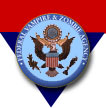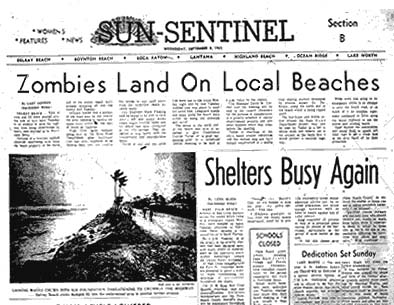

Famous Cases | Historical Tales | Vampires | Zombies
 |  |
Famous Cases | Historical Tales | Vampires | Zombies |
Zombie scourges generally arose in the wake of natural disasters. Almost every significant outbreak in the United States came on the heels of a hurricane, flood or blizzard. But the outbreak that terrorized south Florida in 1970 had its roots not in an act of nature but in the diabolical mind of one evil dictator.
Background: With its tropical climate, Florida was always a hotbed of zombie activity. The worst outbreak in U.S. history took place in Key West after a hurricane in 1935. The Miami office of the FVZA handled an average of 200 zombie cases a year, the most in the continental United States. However, as the Sixties came to a close, zombie attacks were dwindling, and many FVZA zombie specialists found themselves forced into early retirement.
 |
| The first zombies made landfall near the Cape Florida lighthouse |
Investigation: By the time the FVZA team arrived in Key Biscayne, zombie attacks had been reported at Mangrove Acres, a retirement community two miles from the lighthouse. The team exterminated the lighthouse zombie (later confirmed to be Mr. Washburn), then coordinated an evacuation of Mangrove Acres. A total of 11 zombies were exterminated in the operation. The FVZA team later discovered a large boat beached in a snarl of mangroves near the lighthouse. Much of the boat's woodwork had been gnawed away.
More attacks were reported across south Florida over the next week. In Key West, the traditional sunset festivities at Mallory Square were disrupted by a pack of waterlogged zombies. In Fort Lauderdale, four people were trampled to death on the beach by a crush of Spring Breakers fleeing a pack of zombies emerging from the surf. In each case, abandoned boats were found nearby.
 |
| South Florida Sun-Sentinel March 27, 1970 |
When an FVZA team was taken out to the Coast Guard vessel, they found it swarming with zombies. Agent Frank Vinciguerra remembers the sight: "the zombies had picked up our scent and were all crowded on one side of the boat. They seemed to be trying to decide whether or not to jump in the water after us. The way they were waving their arms and grimacing, it looked like they were happy to see us." The boat was scuttled.
Over the next week, five more boats packed with zombies were destroyed in the waters off south Florida. The wave of incidents had authorities puzzled. Where were the zombies coming from? Signs pointed to Cuba, just 90 miles from Key West. Cuba had suffered a major zombie outbreak late in 1969, during which Cuban dictator Fidel Castro repeatedly refused FVZA offers for help. Could the Cuban zombies have commandeered boats and steered them to the United States? Top brass at the FVZA maintained that zombies lacked the intelligence to concoct such a plan.
 |
| A boatload of zombies, courtesy of Fidel Castro |
Post-Mortems: After numerous denials, Castro grudgingly admitted to casting the zombies onto the high seas. In typical fashion, Castro blamed America, claiming that the U.S. trade embargo had led to a shortage of zombie vaccine in Cuba. While some American politicians wanted a military reprisal, cooler heads prevailed: in the end, Washington opted for a stronger trade embargo and a ban on Cuban immigration.
For much of 1970, isolated zombies continued to turn up in south Florida. In one case, an Everglades tour boat full of Germans received a surprise when they eased past a thicket of swamp grass and found themselves face-to-face with a zombie standing waist-high in the muck. The alert tour guide pulled away before the zombie could get to the boat. All told, approximately 100 Cuban zombies made it to the shores of Florida during what's now known as the "zombie boatlift." It's estimated that another hundred zombies were on the boats destroyed offshore. Of the 57 Americans bitten by the zombies, 22 died.
Comments from Dr. Pecos: Cuba has produced many fine exports, including music, cigars and baseball players. But zombies were one export they should have kept to themselves. Of the many dark deeds perpetrated by the Castro regime, the zombie boatlift stands among the worse.